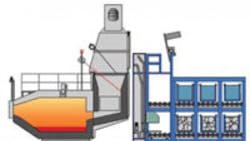High-Productivity Aluminum Melting that Offers High Quality, Too
The StrikoMelter, introduced recently by StrikoWestofen GmbH (www.strikowestofen.com), combines aluminum preheating, heating, and melting in a single, specially configured melting shaft, with a specially designed burner system. It produces molten aluminum according to tight specifications for sand, permanent mold, or diecasting operations.
StrikoWestofen explains that their design objective is to provide an easy-to-maintain, reliable, and durable unit with a process that results in minimal loss of metal, and that meets requirements for highest melt quality.
The patented shaft and melting design concept — called ETAmax — provides three zones of activity: preheating, melting, and holding. The choked shaft design assures consistent preheating of the charge material.
The hot exhaust gases from the holding bath pass through the melting zone, and from there into the preheating zone (and thus are put to use several times over.) The additional energy required for melting comes from burners located in the melting zone and focused into the area at the base of the preheating area; exhaust gasses from these burners also exit through the charged material in the shaft, thereby ensuring drying and a greater degree of preheating. Therefore, there is also greater speed and efficiency of melting. This simple but effective recuperator lowers fuel consumption significantly and greatly reduces the loss of metal.
Due to the furnace design, the charged material is transferred to the holding bath without turbulence and with little waste, and is held accurately at the preset holding temperature. Compared to other furnace designs, this makes possible substantial savings in fuel consumption and consequent lower melting cost. In the practical operation, a power requirement of less than 600 kWh/t was determined — corresponding to a thermal efficiency of over 50%, according to StrikoWestofen.
In addition to the standard charging method for the StrikoMelter, with a lift and tilt unit, fully automatic handling of returns and ingot material are available. With the available charging and furnace units, the physical demands placed on the operators are minimized.
Some advantages claimed for the StrikoMelter:
- Optimal melt quality for producing critical cast parts;
- Minimal loss of metal due to the ETAmax shaft geometry;
- Low energy consumption;
- Long refractory service.
Another design advantage is that aluminum ingots and returns can be safely charged into it, even if they are damp and cold, due to the integrated preheating. Preheating also plays a critical role in ensuring good casting quality. Because aluminum is usually supplied in good metallurgical quality, it is important to ensure that no contamination is introduced during melting (e.g., absorption of atmospheric hydrogen, or inclusions such as oxides and dross.)
The primary source of contamination is moisture from storage of the returns or ingots, which increases hydrogen content in the metal.
The StrikoMelter design avoids this by separating preheating from melting in two zones. Moisture and other contaminants are evaporated or burned off in the shaft by exhaust gases, ensuring that only dry material reaches the melting chamber.
A further advantage is the avoidance of excessive contact of the melt with atmospheric oxygen, thereby reducing oxide formation. To minimize this danger, the burners in the melt chamber are arranged to avoid direct metal impingement. This allows melting only on the hearth and for the metal to flow quickly but without turbulence into the holding bath.
Finally, the furnace was designed to minimize contamination by impurities entering the metal holding bath. This is assured by allowing the metal to run laterally into the holding bath, so that impurities remain on the melt hearth to be removed during cleaning.
